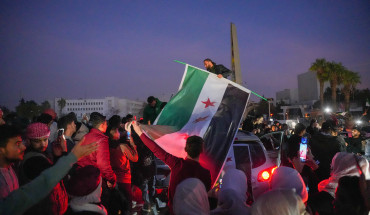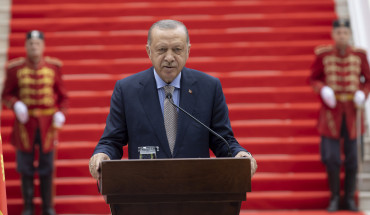Afghan officials say the Iranian government has deepened its ties with the Taliban leadership and increasingly funds, shelters and arms terrorists fighting in Afghanistan, particularly in the three western provinces bordering Iran. They allege that the Islamic Revolution Guards Corps (IRGC) and its secretive Quds Force operatives recruit militants from across Afghanistan and run terrorist training camps for them inside the Iranian territory – further fueling the insurgency and complicating stabilization efforts in the war-ravaged country.
Sheltering and Training Taliban
On December 31, Naser Mehri, the spokesman for the governor of western Farah Province, claimed that the IRGC aided the Taliban and played a prominent role in the latest spike in violence in Farah. In another interview with the BBC Persian, Mehri also cited intelligence showing that bodies of Taliban fighters killed in the province had been transferred to and buried inside Iran. According to the Afghan media, Iran shelters Taliban families on its soil. Rahmatullah Nabil, the former head of Afghanistan’s National Directorate of Security, has also accused Iran of providing the Taliban with weapons and financial aid.
The IRGC’s support for the Taliban is not confined to inside Afghanistan, however. On November 21, Farah’s Governor Mohammad Asif Nang said the IRGC had established military training centers for the Taliban in Birjand, the capital of Iran’s South Khorasan Province, as well as in parts of Khorasan-e Razavi Province. The two provinces share borders with Afghanistan. A report titled “Iranian Taliban?” published by Afghanistan’s largest daily Hasht-e Sobh on November 14 claimed that the Iranian government had recently put a military training facility inside Iran – previously used by Afghan mujahedeen fighters against the Taliban in the 1990s – at the disposal of the Taliban.
The IRGC’s links with local Taliban commanders in western Afghanistan date back to as early as 2002, but Tehran’s recently expanding ties with the Taliban leadership have triggered grave concern among Afghan and American officials. When a US drone strike killed Taliban leader Mullah Akhtar Mohammad Mansour last year, he was reportedly returning from Iran. Jahan News, a conservative Iranian outlet, confirmed that the Taliban leader stayed in Iran for two months before his death and held “diverse meetings with different authorities and institutions.” The outlet described Mansour as an “anti-American figure” who “never allowed the Taliban to hold talks with America, America’s allies and NATO in Afghanistan.”
From Denial to Publicity
In the late 1990s, Iran considered the Taliban a national security threat, backed anti-Taliban Afghan resistance forces, and almost invaded Afghanistan to punish the Taliban for killing its diplomats. But relations between the two ideological nemeses gradually began to thaw after 2002 as Iran saw the American troop presence in its eastern neighbor as a bigger threat.
While most Taliban leaders sought refuge in Pakistan, Iran also provided sanctuary to many leaders of the group; and in the years ahead, the Islamic Republic – albeit to a much lesser extent compared with Pakistan – helped the Taliban regroup and mount a fully-fledged insurgency against the United States and its allies in Afghanistan. Both Tehran and the Taliban denied cooperation during the first decade after the US intervention, but the unholy alliance is no longer a secret and the two sides now unapologetically admit and publicize it.
Last month, for example, Iran’s ambassador to Kabul, Mohammad Reza Behrami, sent shockwaves across Afghanistan by announcing that his government maintained contacts with the Taliban for “control and intelligence” purposes. Tehran “formalized” its partnership with the Taliban in early 2014, when it opened an office for the terrorist group in Mashhad, the capital of Khorasan-e Razavi Province near Afghanistan’s Herat Province.
Nor are the Taliban reticent about their relations with Shiite Iran anymore; on the contrary, the terrorist group boasts that its ties with Iran, Russia and China signify its “legitimacy and recognition” by regional and world powers. Last October, a Taliban official told Pakistan’s Express Tribune that Maulvi Nek Muhammad, a veteran Taliban leader, was now the group’s special envoy to Iran. Last year, a Taliban delegation, led by the group’s military commission chief Ibrahim Sadr, also visited Tehran to “seek military aid.”
Afghanistan’s Senate last month called growing ties between the Taliban and Tehran and Moscow “worrisome,” and pledged to investigate the matter. Top American commander in Afghanistan, General John Nicolson, also expressed concern.
Iran’s Motives
A survey of the Afghan and Iranian press and statements by government officials of the two countries suggest that Iran’s strategy of supporting the Taliban has four key dimensions: to undercut the US mission and accelerate American troop withdrawal from Afghanistan; to establish a buffer zone in western Afghanistan against the threat of the so-called Islamic State along its eastern border; to use its ties with the Taliban for its geopolitical agenda in South and Central Asia as well as in the Middle East; and to pressure the Afghan government for political concessions.
Afghan analysts say Iran is seeking the Taliban’s help to ensure the Islamic State does not find a foothold near its border with Afghanistan and threaten its security. The Islamic Republic has faced a low-intensity insurgency by the disgruntled Sunni community in Sistan and Baluchistan Province for many years and Iranian leaders take the threat seriously. They fear that the Islamic State could exploit the Iranian Sunni minority’s legitimate grievances. According to the Afghan media, the Taliban, with Iranian assistance, managed to dismantle all Islamic State cells in western Afghanistan. Last year, Mohammad Afkhami Rashidi, the head of Iran’s consulate in western Herat Province, described the Islamic State as the common enemy of Afghanistan and Iran, and emphasized that “Iran is prepared to fight Daesh [Islamic State] in Afghanistan” without providing further details.
Moreover, Tehran has also used its ties with the Taliban to extract political concessions from the Afghan government. For example, when Kabul and Washington were negotiating the Bilateral Security Agreement (BSA) in 2013, Iran hosted a Taliban delegation “to send a message to Kabul and Washington that if its concerns regarding the bilateral security pact are overlooked, this government [Iran] will extensively support the Taliban.”
Afghan officials also accuse Iran of using the Taliban to obstruct the construction of water dams in southern and western provinces. “As the agreement for the construction of Bakhtabad dam [in Farah] was finalized, their [Iran’s] support [to the Taliban] increased and the Taliban are threatening Farah’s security with more sophisticated weapons so that work on the Bakhshabad’s dam does not begin,” said Jamila Amini, the head of Farah’s provincial council. Some Afghan officials allege that Iran’s support for the Taliban in Helmand Province, in addition to hurting US troops still stationed in southern Afghanistan, is aimed at ensuring the free flow of Helmand River water into Iran. The Iranian province of Sistan and Baluchistan has been grappling with worsening water shortages and Iranian officials have recently stated that the work on the second phase of the British-built Kajaki dam in Helmand is “extraordinarily worrying to Iran.”
Marriage of Convenience
Iran’s support for the Taliban represents more a marriage of convenience than a strategic alliance. Tehran does not want its ideological foe to come to power in Afghanistan; however, because of perceived threats from the presence of American troops, and recently from the emergence of the Islamic State in Afghanistan, it provides calculated support to the Taliban to expel the American forces and prevent the Islamic State from jeopardizing Iran’s security.
The Middle East Institute (MEI) is an independent, non-partisan, non-for-profit, educational organization. It does not engage in advocacy and its scholars’ opinions are their own. MEI welcomes financial donations, but retains sole editorial control over its work and its publications reflect only the authors’ views. For a listing of MEI donors, please click here.












